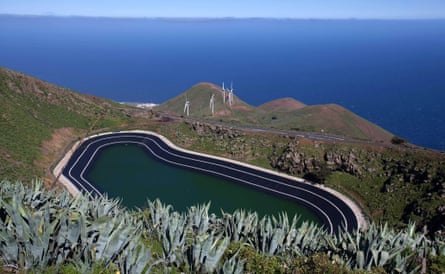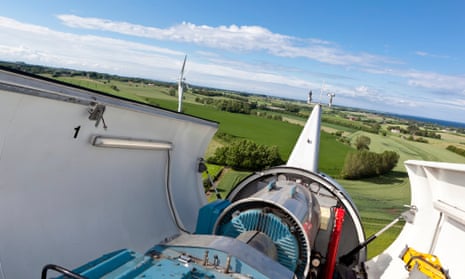With global demand for energy continuing to rise and fossil fuel production buoyed by $5.3tn (£3.4tn) in tax-payer subsidies annually, it is easy to lose hope that cleaner forms of energy will ever catch up. But there are beacons around the world showing the way to an energy future that does not run on coal, oil and gas. Here are nine places that are blazing a trail to a less polluting future.
Greensburg, Kansas
It was only through total disaster that the aptly-named Greensberg, a sleepy, Republican whistle–stop on the Kansas prairie, was able to transform itself into America’s greenest town.
After a massive tornado destroyed 95% of the buildings in the town in 2007, the 1,400 residents had to choose if they would rebuild or relocate. A tough choice in a town that had been in decline for decades.
About half the townspeople left, but a group of residents established a master plan to rebuild the town as an energy-saving, renewable energy haven. Just outside the town, they built a 12.5MW wind farm. This supplies 300% of the town’s electricity, with the excess pumped into the Kansas grid.
But key to this green resurrection has been energy efficiency. Because of the ability to rebuild from scratch, residents were able to apply the most modern building techniques to Greensberg 2.0.
The town now has the highest concentration of gold and platinum eco-design rated buildings in the US and all of its street lights are LED. All large government buildings are now rated platinum. This saves the town over $200,000 a year and, more importantly, reduces the town’s dependence on generating electricity.

Samsø
Since winning a Danish government competition for designing a carbon neutral community in 1997, the island of Samsø, off the east coast of the Danish mainland, and its 3,800 residents have pioneered energy independence. The island has been carbon neutral for aabout five years. All of Samsø’s electricity is produced by 21 wind turbines and 70% of its heating is produced from biomass boilers. The wind electricity the island generates more than offsets the fossil fuels burned by the community’s vehicles and ferries, and plans are afoot to shift over to electric vehicles. By making initial investments in the project, “Samsingers” own about 70% of their electricity infrastructure through a cooperative model. Scientific American has called it “an alternative view of the future”.
Iceland
Few places are as thoroughly predisposed to life without fossil fuels as Iceland. This spectacular volcanic land sits at the head of the mid-Atlantic ridge, where the tectonic plates of North America and Eurasia are splitting apart and the Earth’s mantle bubbles towards the surface. The Icelandic people, so long impoverished by their reliance on burning peat and imported coal from Europe to survive, have harnessed this heat to enable an almost total transition from the fossil-powered past.
All of Iceland’s electricity comes from renewable sources, three quarters from hydroelectric dams on the glaciers and mountain sides and the rest from geothermal. Bores are drilled 1-2 miles into the thin crust of earth. Water pumped down into the hot rocks returns as high pressure steam, spinning turbines to produce electricity.
The country also uses this heat directly. Two-thirds of the country’s primary energy comes from geothermal. Hot water is everywhere and is tapped to heat homes and offices. The streets of Reykjavik are kept snow and ice free in winter through a system of heated water pipes.
None of this, however, has stopped the Icelandic government seeking to exploit the oil and gas reserves of its surrounding seas.

El Hierro, Canary Islands
In another example of making use of what you’ve got, the 12,000 residents of the Spanish island of El Hierro use their extra wind energy to pump water into the sealed crater of an extinct volcano, 700m above sea level. Then, when the wind drops, the water runs through a hydroelectricity plant ensuring an uninterrupted supply. It’s a huge, unusual and very effective battery.
The island is the most remote of the Canary Island chain and once generated power from an expensive diesel generator. They claim to be the first island to have evolved to electricity self-sufficiency without connecting to a grid first – unlike Samsø.
“When they turn on the light, they think of the windmills moving and maybe they think, ‘We are different than the rest of the world, because we are catching electricity from these windmills and not from conventional engines,’” the island’s governer Alpidio Armas told NPR last year.

Copenhagen
If the western world, with its cities built on billions of tonnes of carbon emissions, is to do its fair share to defeat climate change then it must look to the Danish capital as a model for the future. Copenhagen ranks as the greenest city on Earth in the Siemens/Economist Green City Index and was Europe’s Green Capital in 2014.
But beyond the rankings, Copenhagen is truly breaking new ground. It is set to be carbon neutral by 2025. This will involve halving its emissions and offsetting its remaining carbon use by producing more renewable energy than it consumes.
By focussing on building standards and energy efficiency, the city believes it can make large inroads into its energy consumption. Dolf Gielen, a director at the International Renewable Energy Agency (Irena), said cold cities with large heat energy requirements are counterintuitively well placed to shift their heat to renewable sources because they often have large scale centralised heat plants – rather than boilers in every home. By 2025, the city says 75% of all journeys will be by foot, cycle or public transport.
Copenhagen is now considering how it can transition away from fossil fuel use altogether by 2050. This will go a long way to helping the Danish government achieve its national goal of independence from fossil fuels in the same time frame.
Professor Brian Vad Mathiesen, who authored a report on Copenhagen’s 2050 strategy, said the goal was possible and, most importantly, replicable.
“The vision we created for Copenhagen as a city based on 100% renewable energy in 2050 can be seen as a paradigm that many other ambitious cities can copy around the world,” he said.

Samoa
Like many small, isolated islands, Samoa’s need to ship in diesel for electricity generation has led to high power prices and been a boot on the throat of the developing economy. For these islands, says Irena’s Gielen “it makes perfect sense to switch to renewables”.
The government has set itself the target of achieving 100% renewable electricity generation by 2017 and is well on course. Last year the UN climate chief Christiana Figures congratulated Samoa on being a leader among small island states as they attempt to bypass the fossil fuel economy.
The government and developers have used the island’s rivers, sunlight and wind to generate electricity. Last year, the country’s first wind farm was completed. The two turbines will cut annual fossil fuel expenditure by $475,000. Because of the regular occurrence of tropical storms, the turbines are designed to fold away their blades when necessary, protecting them from destructive winds.
Fukushima
Devastated by tsunami in 2011 and still suffering from the radiation spilled by the Daiichi Nuclear Power Plant, the prefecture of Fukushima has declared its intention to rebuild itself as a renewable energy haven.
As a country, Japan was left deeply scarred by its experience with nuclear disaster. The fallout from Fukushima has been a dramatic rise in carbon emissions as nuclear reactors across the country were switched off and fossil fuels were poured into the breach. By March last year, after years of strong cuts before the disaster, emissions had risen to their second highest level on record.
But Fukushima’s government has committed to building enough renewable electricity capacity to supply its 2 million residents by 2040. Driving the transition is a focus on community scale solar and wind plants. By 2020, the prefecture aims to have 143 floating wind turbines with a capacity of 1GW installed.
Orkney
The Orkney islands are home to Europe’s most productive wind turbine. During April, NM92 became the first wind turbine in Europe to click over 100,000,000 kWh – enough electricity to power a typical UK home for over 30,000 years. With it’s total exposure to winds sweeping out of the Northern Atlantic, Orkney – which translates from Icelandic to ‘energy islands’ – has become a beacon for renewable energy consistently producing more renewable electricity than they consume. Advanced testing of wave and tidal generation is also underway.
The cheap, clean energy has led to a growing demand for electric vehicles. Currently 50 cars cruise the islands, about 5% of the entire Scottish electric vehicle market. Orkney has just 0.4% of the country’s population.
Tianjin Eco-city, China
While it’s not a done deal, Tianjin Eco-city provides a clue to how China might answer the question: what are you going to do with all these millions of newly middle-class, high carbon-emitting citizens?
The Eco-city is a $24bn model of sustainability. It is being built from scratch and, when complete, will be able to accomodate 350,000 residents. It is just one of hundreds sprouting across China as the urban population, swelled by the rural poor, grows by 13m each year. The city puts a premium on energy efficient buildings – a must for a country where coal smog has cut life expectancy in some areas by 5.5 years. Public transportation and modern urban planning will also help to cut pollution and carbon emissions.

But a Guardian visit last year found the Eco-city remained largely empty, an environmentally-friendly Potemkin city of empty highways and just 6,000 people, meaning the project remains an incomplete vision of a healthier, less-polluted China.

Comments (…)
Sign in or create your Guardian account to join the discussion